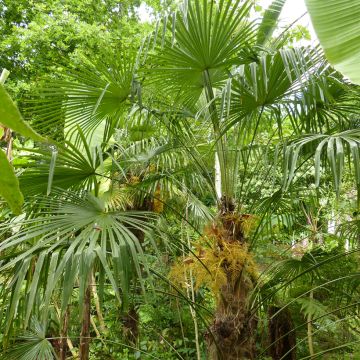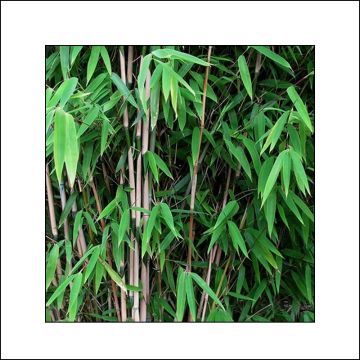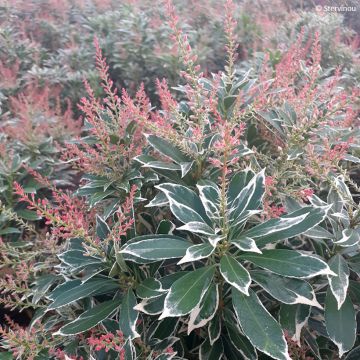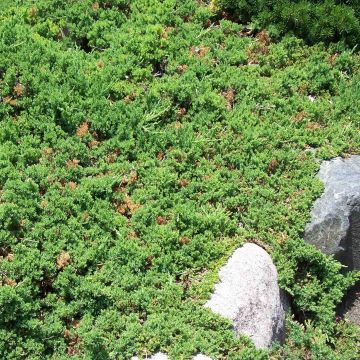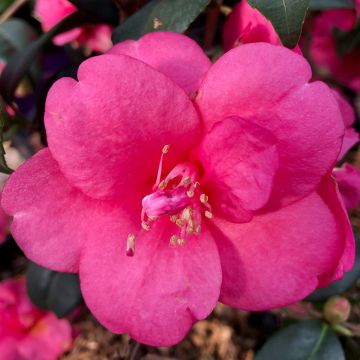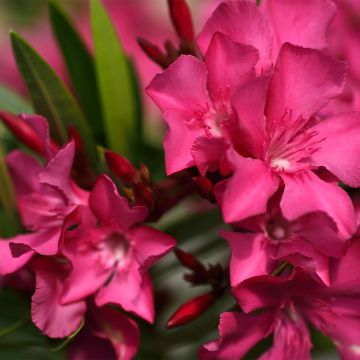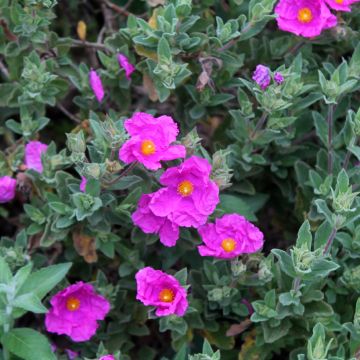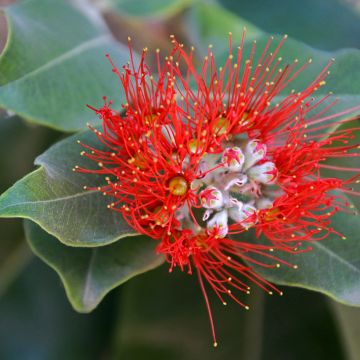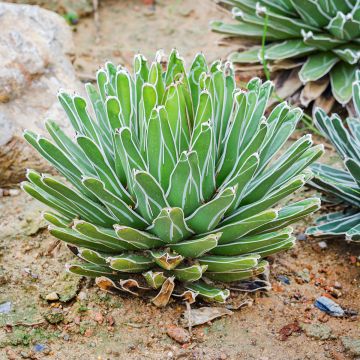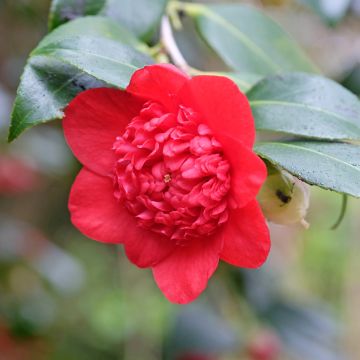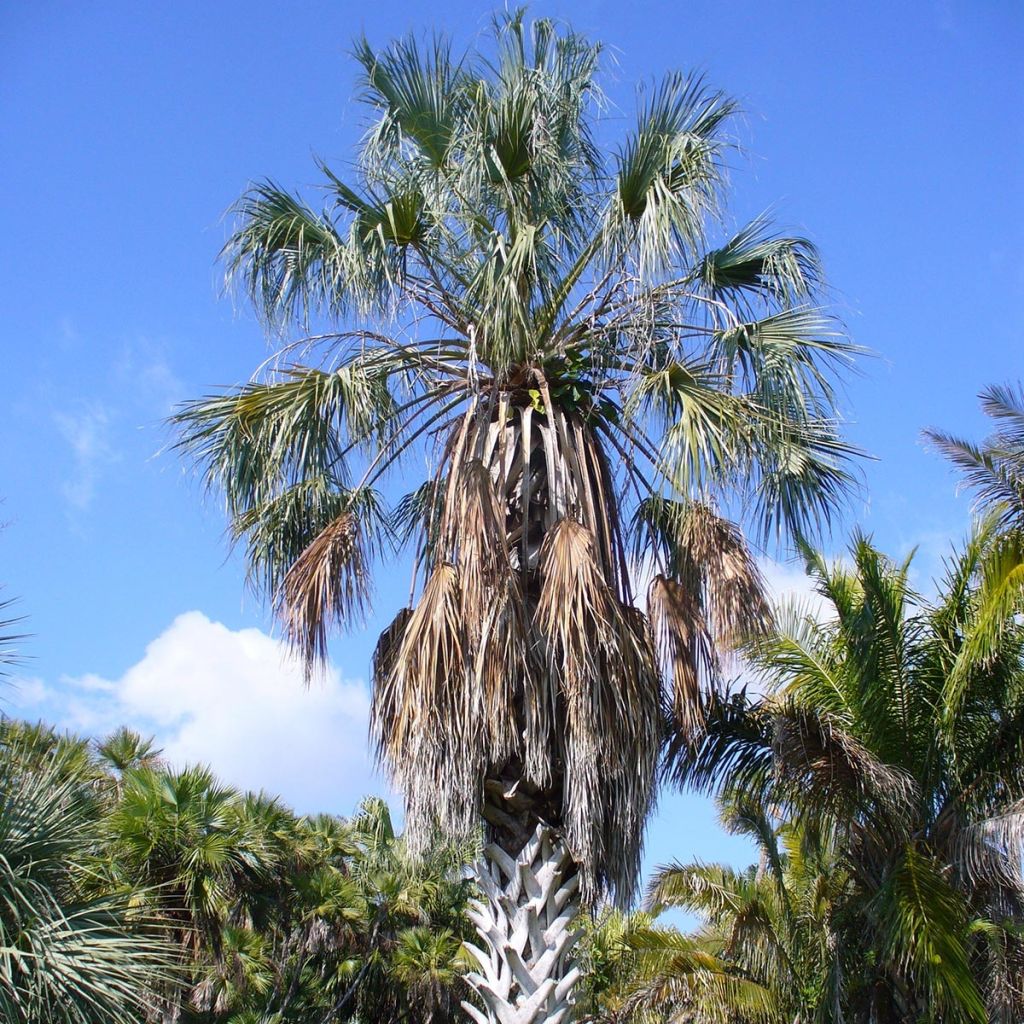

Sabal uresana - Palmier sabal bleu
Sabal uresana - Sonoran Palmetto
Sabal uresana
Palma Blanca, Sonoran Palmetto
This plant carries a 24 months recovery warranty
More information
We guarantee the quality of our plants for a full growing cycle, and will replace at our expense any plant that fails to recover under normal climatic and planting conditions.
From €5.90 for pickup delivery and €6.90 for home delivery
Express home delivery from €8.90.
Does this plant fit my garden?
Set up your Plantfit profile →
Description
Sabal uresana, sometimes called the Palma Blanca, is a large palm tree emblematic of the deserts of Chihuahua and Sonora, still rare in cultivation. With its numerous qualities, it definitely deserves to be planted more in our gardens. It proudly stands on these desolate expanses, with its majestic silhouette composed of a trunk adorned with geometric patterns, topped by a rounded crown of beautifully coloured arched palm fronds in shades of blue-silver when young. It is hardy down to -10°C, and even more so for older specimens, and has few soil requirements as long as it is well-drained. Despite its slow growth, it is an exceptional species for a dry and unirrigated garden, even in windy conditions. Majestic and remarkably colourful, resistant to both cold and drought, the Blue Sabal has a promising future in our gardens.
Sabal uresana, also locally known as the Sonoran Palmetto, belongs to the family of Arecaceae. It is native to Mexico, where it can be found in dry forests as well as desert areas. This palm tree, which can slowly reach a height of 10 to 15m (33 to 49ft) in some areas of Europe, can grow up to 20m (66ft) tall in its native habitat. Its growth is very slow. It is supported by a single trunk (stipe), thickened at the base, straight, massive, grey in colour and with a woven appearance. These patterns, characteristic of this species, are the remains of the dried petioles. The foliage is arranged in a terminal crown at the top of the trunk, and can eventually reach a span of 6 to 8m (20 to 26ft). The crown is composed of large costapalmate leaves, meaning palmate leaves arranged in a fan shape around a central axis. On Sabal uresana, each leaf, rough to the touch, greenish-blue to bluish-grey in colour and later turning green, is covered with a white coating. It is divided into numerous rigid segments, tapering and drooping at the tips. The petiole that bears the leaves is smooth and very visible.
Flowering, which occurs in summer on very old individuals, consists of pale yellow flowers that will give rise, in favourable climates, to round fruits, brown in colour, each containing a black pear-shaped seed.
Its hardiness, quite commendable, certainly depends a lot on soil drainage and ambient humidity. It is a valuable species for ornamental purposes in windy and very dry southern gardens in summer, but it will also adapt very well to more watered regions, as long as the summer is hot and the winter not too harsh. Perfect by the seaside, this palm tree will also thrive inland. It can be planted on either side of a gate, as a standalone specimen near a pool, or in a large exotic bed. To accompany it, consider, for example, Agaves, Oponces, Eucalyptus, cycads and mimosas.
Report an error about the product description
Sabal uresana - Sonoran Palmetto in pictures
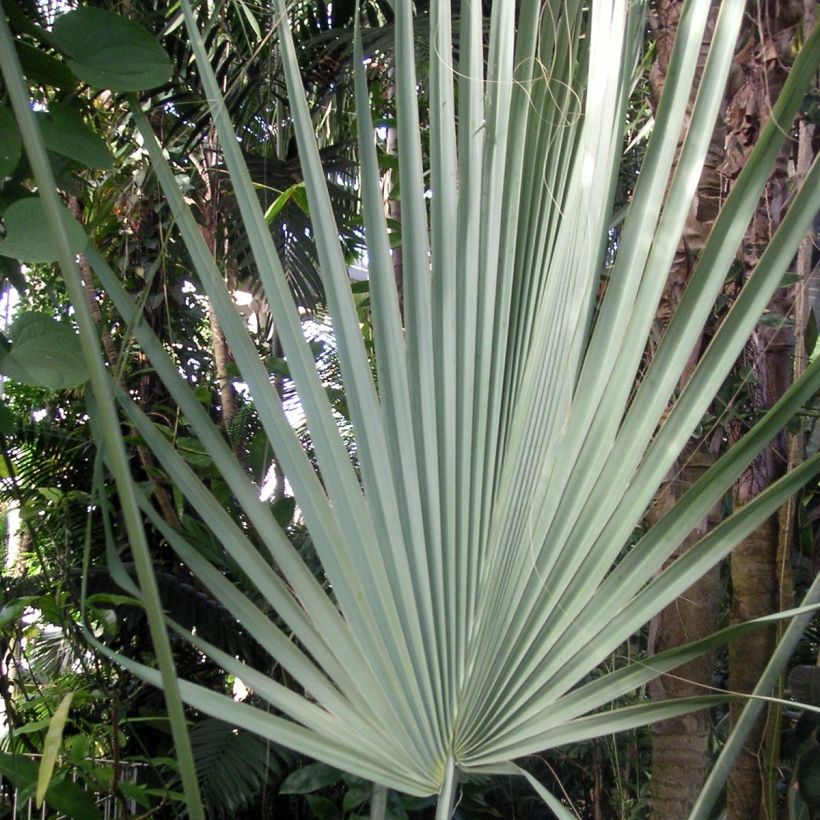

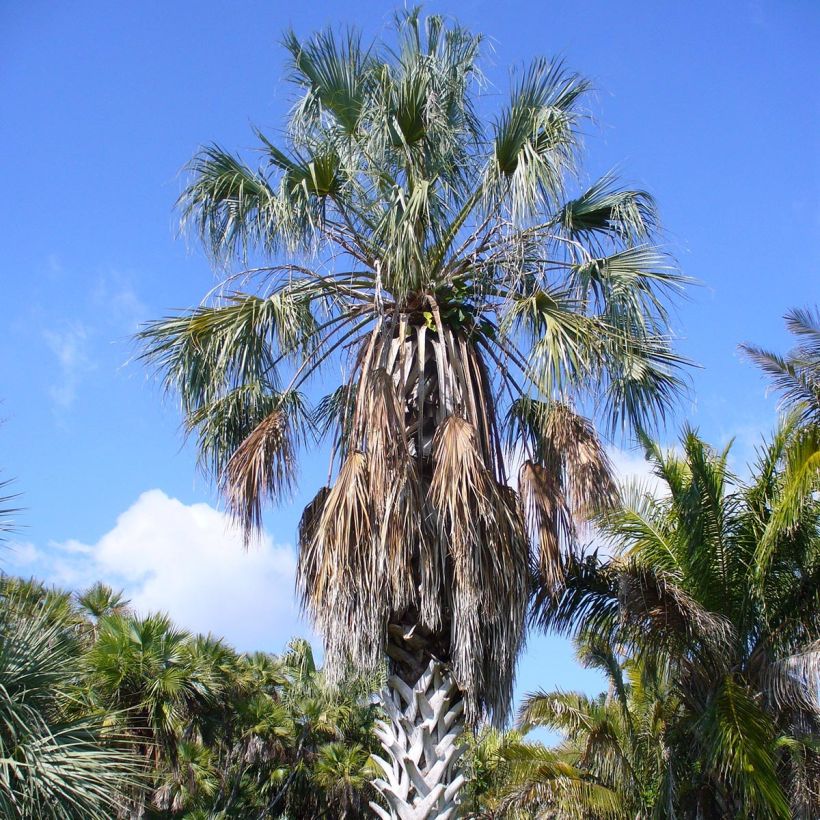

Plant habit
Flowering
Foliage
Botanical data
Sabal
uresana
Arecaceae
Palma Blanca, Sonoran Palmetto
North America
Other Sabal
Planting and care
This palm tree shows slow growth, especially during its first 8 or 10 years, and requires sunlight and warmth that will promote faster development. Plant Sabal uresana in open ground in warm regions in summer and spared by strong frosts, it can tolerate up to -12°C (10.4°F) once fully grown. Plant it in a very well-drained soil, even sandy and salt-rich, but light, deep, and loose. Choose the warmest and sunniest spot in the garden. Regular watering in summer promotes the growth of young plants. Once well-rooted, this Sabal can withstand long periods of drought. This species also tolerates dry and hot winds. This palm tree requires little maintenance, except for pruning the oldest palm leaves close to the stem.
Planting period
Intended location
Care
This item has not been reviewed yet - be the first to leave a review about it.
Evergreen shrubs
Haven't found what you were looking for?
Hardiness is the lowest winter temperature a plant can endure without suffering serious damage or even dying. However, hardiness is affected by location (a sheltered area, such as a patio), protection (winter cover) and soil type (hardiness is improved by well-drained soil).

Photo Sharing Terms & Conditions
In order to encourage gardeners to interact and share their experiences, Promesse de fleurs offers various media enabling content to be uploaded onto its Site - in particular via the ‘Photo sharing’ module.
The User agrees to refrain from:
- Posting any content that is illegal, prejudicial, insulting, racist, inciteful to hatred, revisionist, contrary to public decency, that infringes on privacy or on the privacy rights of third parties, in particular the publicity rights of persons and goods, intellectual property rights, or the right to privacy.
- Submitting content on behalf of a third party;
- Impersonate the identity of a third party and/or publish any personal information about a third party;
In general, the User undertakes to refrain from any unethical behaviour.
All Content (in particular text, comments, files, images, photos, videos, creative works, etc.), which may be subject to property or intellectual property rights, image or other private rights, shall remain the property of the User, subject to the limited rights granted by the terms of the licence granted by Promesse de fleurs as stated below. Users are at liberty to publish or not to publish such Content on the Site, notably via the ‘Photo Sharing’ facility, and accept that this Content shall be made public and freely accessible, notably on the Internet.
Users further acknowledge, undertake to have ,and guarantee that they hold all necessary rights and permissions to publish such material on the Site, in particular with regard to the legislation in force pertaining to any privacy, property, intellectual property, image, or contractual rights, or rights of any other nature. By publishing such Content on the Site, Users acknowledge accepting full liability as publishers of the Content within the meaning of the law, and grant Promesse de fleurs, free of charge, an inclusive, worldwide licence for the said Content for the entire duration of its publication, including all reproduction, representation, up/downloading, displaying, performing, transmission, and storage rights.
Users also grant permission for their name to be linked to the Content and accept that this link may not always be made available.
By engaging in posting material, Users consent to their Content becoming automatically accessible on the Internet, in particular on other sites and/or blogs and/or web pages of the Promesse de fleurs site, including in particular social pages and the Promesse de fleurs catalogue.
Users may secure the removal of entrusted content free of charge by issuing a simple request via our contact form.
The flowering period indicated on our website applies to countries and regions located in USDA zone 8 (France, the United Kingdom, Ireland, the Netherlands, etc.)
It will vary according to where you live:
- In zones 9 to 10 (Italy, Spain, Greece, etc.), flowering will occur about 2 to 4 weeks earlier.
- In zones 6 to 7 (Germany, Poland, Slovenia, and lower mountainous regions), flowering will be delayed by 2 to 3 weeks.
- In zone 5 (Central Europe, Scandinavia), blooming will be delayed by 3 to 5 weeks.
In temperate climates, pruning of spring-flowering shrubs (forsythia, spireas, etc.) should be done just after flowering.
Pruning of summer-flowering shrubs (Indian Lilac, Perovskia, etc.) can be done in winter or spring.
In cold regions as well as with frost-sensitive plants, avoid pruning too early when severe frosts may still occur.
The planting period indicated on our website applies to countries and regions located in USDA zone 8 (France, United Kingdom, Ireland, Netherlands).
It will vary according to where you live:
- In Mediterranean zones (Marseille, Madrid, Milan, etc.), autumn and winter are the best planting periods.
- In continental zones (Strasbourg, Munich, Vienna, etc.), delay planting by 2 to 3 weeks in spring and bring it forward by 2 to 4 weeks in autumn.
- In mountainous regions (the Alps, Pyrenees, Carpathians, etc.), it is best to plant in late spring (May-June) or late summer (August-September).
The harvesting period indicated on our website applies to countries and regions in USDA zone 8 (France, England, Ireland, the Netherlands).
In colder areas (Scandinavia, Poland, Austria...) fruit and vegetable harvests are likely to be delayed by 3-4 weeks.
In warmer areas (Italy, Spain, Greece, etc.), harvesting will probably take place earlier, depending on weather conditions.
The sowing periods indicated on our website apply to countries and regions within USDA Zone 8 (France, UK, Ireland, Netherlands).
In colder areas (Scandinavia, Poland, Austria...), delay any outdoor sowing by 3-4 weeks, or sow under glass.
In warmer climes (Italy, Spain, Greece, etc.), bring outdoor sowing forward by a few weeks.


































